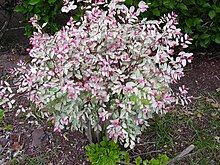

| Breynia | |
|---|---|

| |
| Breynia disticha | |
| Scientific classification | |
| Kingdom: | Plantae |
| Clade: | Tracheophytes |
| Clade: | Angiosperms |
| Clade: | Eudicots |
| Clade: | Rosids |
| Order: | Malpighiales |
| Family: | Phyllanthaceae |
| Subfamily: | Phyllanthoideae |
| Tribe: | Phyllantheae |
| Genus: | Breynia J.R.Forst. & G.Forst. (1776), nom. cons. |
| Species[1] | |
|
93; see text | |
| Synonyms[1] | |
Breynia is a genus in the flowering plant family Phyllanthaceae, first described in 1776. It is native to Southeast Asia, China, Réunion, the Indian Subcontinent, Papuasia and Australia.[1]
The name Breynia is a conserved name, it is recognized despite the existence of an earlier use of the same name to refer to a different plant. Breynia L. 1753 is in the Capparaceae, but it is a rejected name. We here discuss Breynia J.R.Forst. & G.Forst. 1776.[2]
In a 2006 revision of the Phyllanthaceae, it was recommended that Breynia be subsumed in Phyllanthus; however, new combinations in Phyllanthus for former Breynia species remain to be published.[3]
Breynia are of special note in the fields of pollination biology and coevolution because they have a specialized mutualism with moths in the genus Epicephala (leafflower moths), in which the moths actively pollinate the flowers—thereby ensuring that the tree may produce viable seeds—but also lay eggs in the flowers' ovaries or in the space between the tepals and the carpel walls, from where their larvae consume a subset of the developing seeds as nourishment.[4][5] Other species of Epicephala are pollinators, and in some cases, non-pollinating seed predators, of certain species of plants in the genera Phyllanthus[6][7] and Glochidion,[8][9][10] both closely related to Breynia.[11] This relationship is similar to those between figs and fig wasps and yuccas and yucca moths.
93 species are accepted.[1]